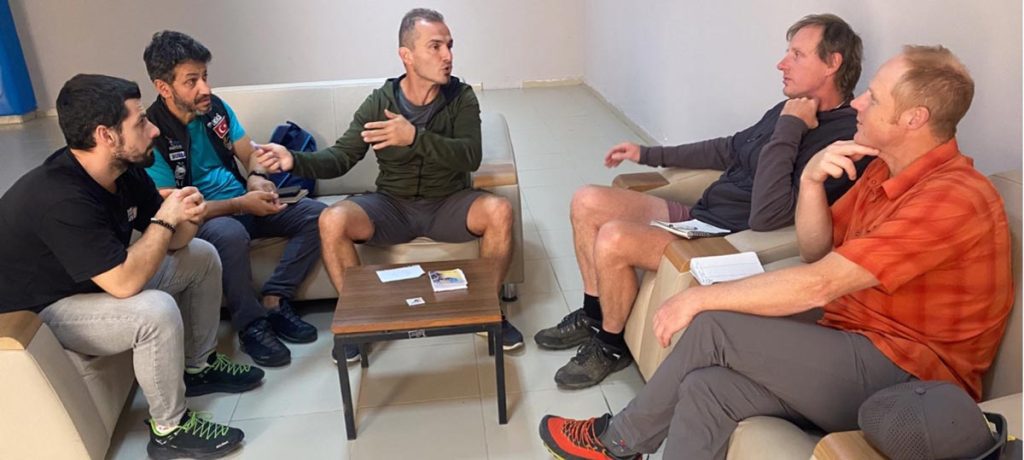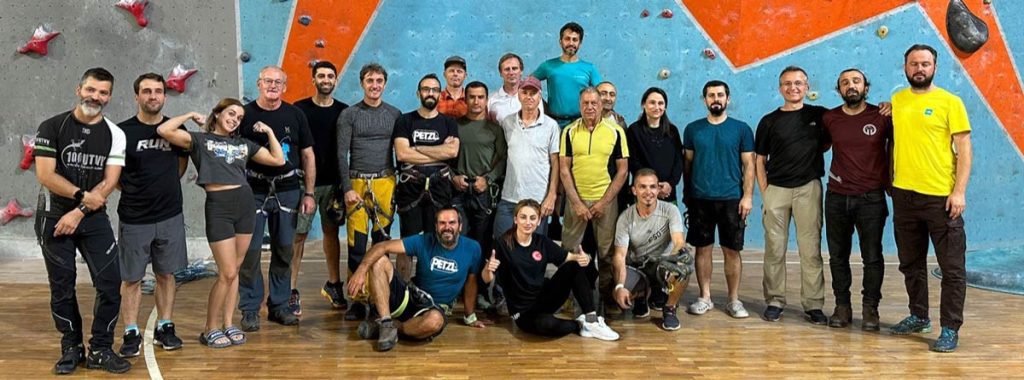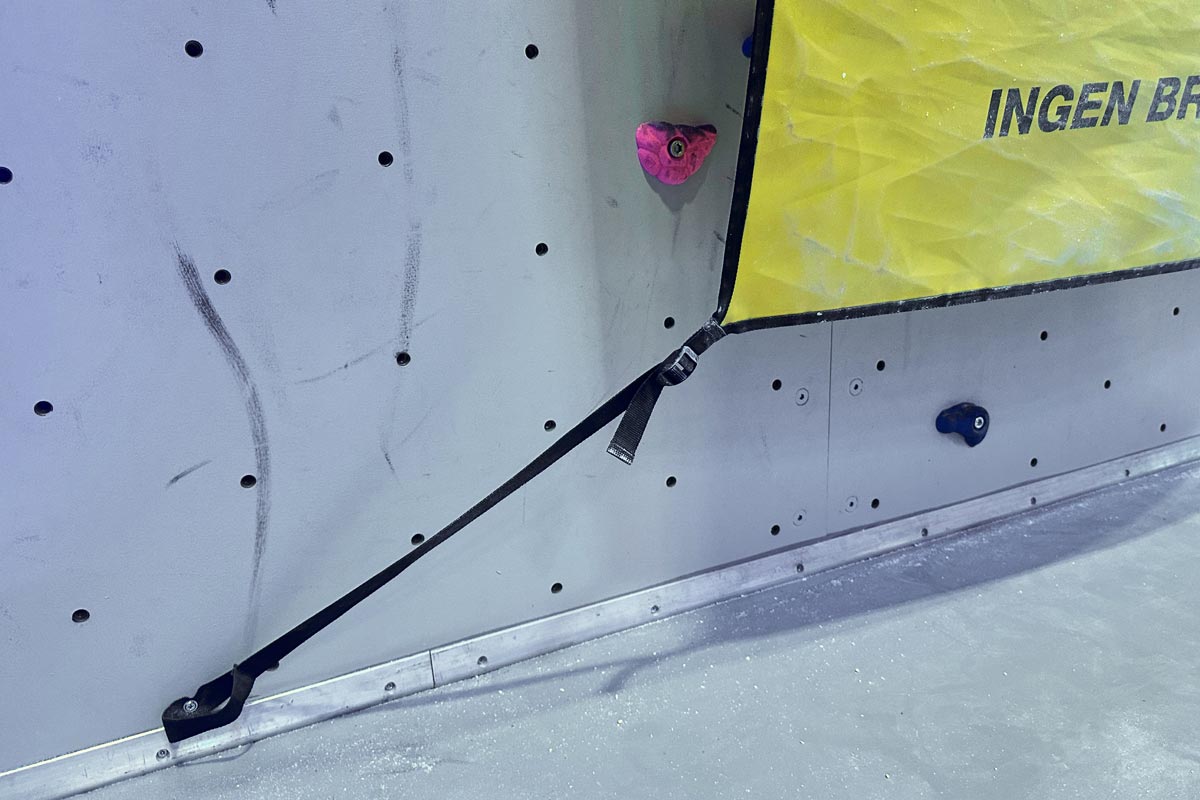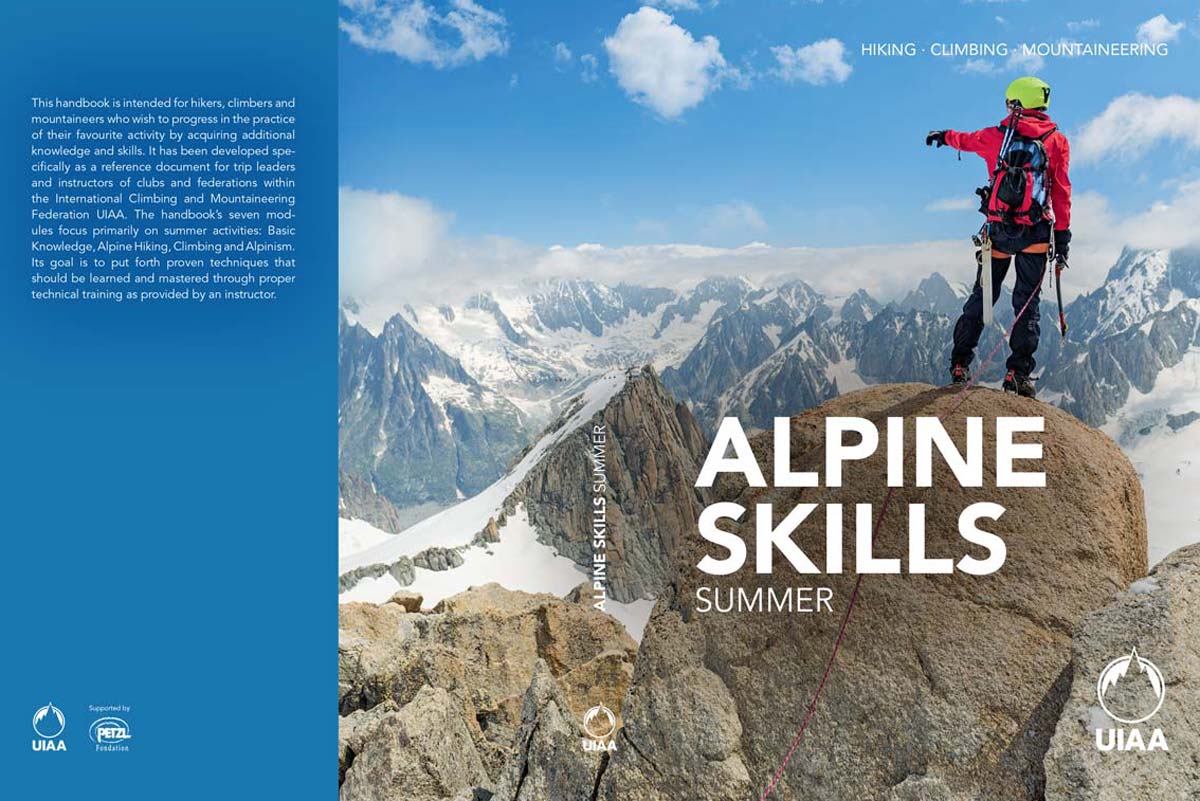The 2023 UIAA General Assembly took place in Trabzon, Türkiye in October. The GA encompassed a number of meetings and events which are profiled in a detailed review. One aspect the UIAA seeks to offer GA hosts is opportunities to benefit from the expertise of different UIAA Commissions. In Trabzon, the UIAA Training Commission (TC) took the opportunity to conduct a seminar for local guides and prospective mountain leaders.
This seminar was attended by delegates from the Turkish Mountaineering Federation (TDF). Most of the Turkish delegates are sport climbing coaches, but some also have a mountaineering background. All of the UIAA Training Commission are present or past heads of training for their respective federations, in several cases the national head of training for mountain activities.
The aim of the seminar was to work collaboratively towards setting more detailed standards for some of the Mountain Qualification Labels, and to increase understanding of the accreditation process for the UIAA. The seminar was led by the Training Commission President, Steve Long, and the following report is courtesy of the TC.
TDF Seminar
The programme was very flexible, to allow the freedom to address the delegates’ expressed interests. A long discussion ensued about the safeguarding of vulnerable people – it was gratifying to note that this is an important issue for coaches in Türkiye, because these issues exist anywhere that the potential for power or status differences exist, and social media also presents many opportunities to overstep social boundaries or to create inappropriate user groups. Among the issues discussed, one common theme was the importance of keeping online communications to and from the coach transparent, without undermining the value of creating internal communication paths between athletes. It was also encouraging to see so many women in senior roles within coaching. These observations demonstrate a student-centred approach to coaching that was less evident at previous seminars in the region. Many federations have developed resources and/or workshops for building awareness of these issues, or they make use of the many online courses that already exist. For example, in the UK safeguarding training is an essential part of the climbing coach qualifications. A useful summary of the issues can be found here. The UIAA is currently developing its own safeguarding policy, for release in early 2024.
The attendees split into three working groups to discuss and propose a detailed list of the essential components of a leader or instructor’s skillset. Each group worked on one of the following activity categories, based on the specific experience within the group: sport climbing, trad (leader-placed protection) climbing, and mountaineering. Each working group was chaired by a member of the TC. The main value of such groups is the discussion between peers, but the following materials were presented back at the plenary session following this session.
After lunch the course moved to the nearby climbing wall. A useful but generally brief discussion was conducted on various issues at the climbing wall, despite the limitations of the venue due partly to route-setting obligations for a climbing competition. However the Training Commission was able to provide advice related to warm-up procedures, the strength and weaknesses of the bouldering facility, and the main climbing wall.

There was a discussion about safe ratios for teaching climbing. The danger of novice belayers pulling on the “live” rope rather than through the belay device was noted i.e. novices often get out of sequence, allowing slack to build up. The pros and cons of “tubing/tunnelling” (i.e. sliding the hand up the rope when taking in slack) were briefly discussed. Steve Long proposed that a slightly larger group can be managed if each member has a role within the belay chain (six people, but ideally an assistant instructor should be present too). Even larger groups can be managed but only if another instructor is available to manage a bouldering session or other activity.
However, the maximum number of ropes that can be securely controlled by the instructor is limited by their number of hands, i.e. no more than two ropes active at any one time – moreover the routes need to be close enough to each other to allow the instructor to “tail-end” one rope in each hand effectively. It is also important that discipline is maintained, otherwise exuberance can tempt climbers to embark on a climb without the explicit approval of the instructor. Steve Long pointed out that for indoor gyms there is little use for gear loops, so to avoid the risk of attaching the rope to them instead of the main harness, options include:
- Insist that knots are used rather than clipping in with a karabiner (or even two carabiners)
- Remove the front gear loops entirely from the facility harnesses
- Insist on buddy-checks before leaving the ground.
The Training Commission recommended a system for teaching the worst-case consequences of a fall before clipping a bolt. A top-rope was set up to allow a mock lead. The climber is safeguarded by the top-rope, controlled by a belayer. The mock belayer pays out just enough rope for the lead climber to clip a bolt. This rope is then locked, and the climber is lowered on the top-rope until the mock lead rope is tight. This provided a thought-provoking demonstration that the climber would invariably hit the ground from near any of the first 3 bolts if pulling the rope up to clip a runner beyond head height. It could also demonstrate that although making an extra step up before trying to clip the bolt is counter-intuitive, it reduces the potential fall significantly and can make the difference between an ankle-breaking fall and a near miss. However, for a clean demonstration, instructions need to be very clear to the climber and both belayers.
Discussion about recognition of national qualifications
The question was raised: since academic qualifications are recognised worldwide, why aren’t mountaineering qualifications? The simple answer is that they are: the IFMGA (International Federation of Mountain Guides Associations) and UIMLA (Union of International Mountain Leader Associations) carnets are recognised worldwide as appropriate for working professionally for activities within their remit. However, both these qualifications are holistic in nature and follow a strict standard for training, assessment, and Compulsory Professional Development. By contrast, federation qualifications vary dramatically.
As a simple example, one country might regard UIAA grade 8+ as the minimum technical standard for a climbing instructor but note that Grade 5 or 6 is the standard for most other countries. Therefore, this country would probably require an additional assessment of personal climbing ability at the very least. Since each federation has its own autonomy, there is no obligation to accept another country’s interpretation of what is essential, desirable or merely nice to know. Similarly, climbing gyms are strongly influenced by their insurers, and in many countries a physical belay test before using the gym is required even for IFMGA members, who are qualified at a suitable level to train and assess the climbing wall’s belaying testers. Another reason is that because of competition for high quality lecturers, academic institutions have been motivated to implement and follow international standards.
This is one of the reasons that the training standards that underly the UIAA Mountain Qualification Labels were developed in the first place. By reaching an agreement on common standards, any country can make an informed choice about bridging any gaps that exist between the UIAA standard and their own qualification. This is entirely at the discretion of each country. Some federations are restricted by government employment rules, which for example may insist on a certain academic level to be included with a mountain qualification – for example specific training in physiology, wilderness first aid, geology – the list goes on – whereas other countries may prioritise the leadership skills and awareness rather than specific academic subjects. In other words, despite being a vocational craft, the academic content can vary widely from one country to another.
Although UIAA’s Mountain Qualification Labels have achieved some success at assisting cross-recognition of qualifications, particularly for voluntary work, the TC believe that more development is required. This is why this seminar had the objective of creating more detail within the syllabus of the learning outcomes for personal skills, since if the UIAA can reach wide consensus on the essential skills and knowledge of a participant, these must surely also be essential for any leader or instructor of a specialised qualification. In turn, this will assist the TC validators in advising federations about any important omissions from their training programme.
For further details on the UIAA’s training programmes, and association Mountain Qualification Labels, please click here.
To contact the UIAA Training Commission please write to training@theuiaa.org
Images courtesy of UIAA Training Commission




